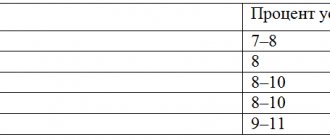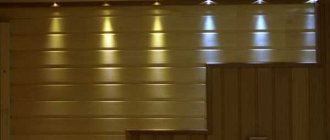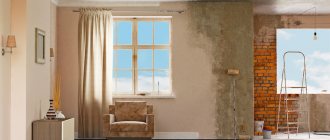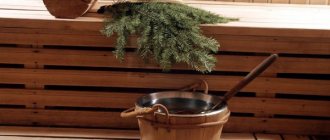Interior decoration creates coziness and a pleasant atmosphere in the room. Wood is considered a practical and environmentally friendly type of finishing materials for a bath. Due to the fact that the room is exposed to high temperatures and humidity, not all types of wood are suitable for interior decoration. The sauna board is made from varieties of wood that are resistant to temperature changes.
Is it possible to use a terrace board in a bathhouse?
Terrace board is a popular material used for interior decoration of baths. It is manufactured for use in the fresh air and in conditions of high humidity. Additional treatment with resins increases resistance to the formation of mold, fungi, and bacterial development.
The decking board has a corrugated surface. Parallel furrows allow you to effectively organize a drainage system. It will not allow moisture to destroy the structure of the floor. The floor, made of terrace boards, is non-slip. If installed correctly, it looks beautiful and expensive.
Repairing a leaking floor
So, how to lay the floor in a bathhouse from boards so that it freely passes water through them? To do this you should:
- prepare boards, uncut and pre-planed, with straight ends;
- cut each board to size, taking into account the gaps between them and the walls for ventilation;
- installation work is allowed to be carried out from any wall;
- The first board is nailed two centimeters from the wall. Nails for this purpose are chosen in length twice as long as its thickness. You need two of them for each joist; they should be driven in at an angle of forty degrees, from the center of the board;
- Each subsequent board is sewn at intervals of a couple of centimeters. To ensure that the distances are the same, it is recommended to make a template from scraps. For the dressing room, this condition may not be observed - a terrace board in a bathhouse in such a room would be quite appropriate;
- Having finished laying, the boards should be treated with protective agents. There is no need to paint them so that they dry faster and better after getting wet.
How to cover the inside of a bathhouse except for lining
Lining is a universal bathhouse cladding material: walls, floor, ceiling. But the room will look monotonous. Designers recommend using a variety of finishes for bathhouses. The choice of finishing material depends on the purpose of the room.
For the steam room, it is better to choose environmentally friendly material that is resistant to humidity and which, when heated, does not emit substances hazardous to human health. Two materials correspond to these parameters:
- salt slabs;
- tree.
Salt slabs are rectangular plates of compressed salt. When heated, they create the effect of being in a salt cave. This environmentally friendly material has a beneficial effect on the condition of the lungs, bronchi and the respiratory system as a whole. The disadvantage of the slabs is their high cost and expensive installation. Specialists capable of working with this material are rare in Russia and the CIS.
The wood finish option is more attractive. Wood is less capricious than salt, and the range of wood is wide: timber, edged or unedged, terrace boards. You should not try to decorate the steam room and bathhouse premises with plywood, OSB, chipboard and similar building materials. When heated, they release toxic fumes.
The ceilings in the steam room can be easily decorated using frosted glass. It is appropriate to lay terrace boards, heat-resistant tiles, and clinker on the floor.
The bathroom in the bathhouse is tiled with tiles, tiles, and mosaics. It's cheap and practical. If the bathroom is lined with traditional clapboard, you will have to treat the boards with moisture-resistant compounds. Treatment is carried out to prevent the development of fungus.
They tend to line the dressing room with the same material as the steam room. This increases the cost of finishing several times. For the dressing room, it is permissible to use cheap types of wood and combine it with other materials: tiles, wall painting, and the use of decorative elements.
A special place in the bathhouse is occupied by the relaxation room. Any materials are used to decorate the room: wallpaper, MDF panels, vinyl tiles, paint. Tiles, wood, natural linoleum, and clinker are laid on the floor.
Despite the wide choice of finishing materials, most people prefer wooden materials. This is due to their practicality, affordable price and durability. We will talk about panels made from different types of wood below.
Linden board for bath
A popular material for making bath boards is linden. Linden has a low density. The wood is homogeneous and characterized by low thermal conductivity. It does not heat up, it is impossible to get burned on its surface. Linden wood is resistant to temperature changes and humidity. The board does not crack and is not subject to deformation. Such characteristics make linden an almost ideal option for cladding a bathhouse.
The lime board has its disadvantages. The most serious disadvantage of this material is that in conditions of high humidity this material is susceptible to the formation of mold and mildew. The board will have to be treated with antibacterial compounds. Experts advise mounting linden boards horizontally. This arrangement will allow you to replace damaged elements with new ones.
The second disadvantage of the lime board is the price. It is more expensive than aspen, pine, larch. The cost depends on the class of wood:
- "Extra";
- "A";
- "IN".
Another nuance that you need to know about linden boards is color changes. She's getting dark. After 5–6 years of operation, the sheathing will need to be replaced or its surface updated.
Larch board
Another type of wood used in the production of bath boards is larch. Wood is characterized by low thermal conductivity and maintains the temperature and microclimate in the room for a long time. Larch is not afraid of temperature changes and humidity. Due to the content of natural resin, when exposed to moisture, the material increases strength, does not rot, and does not need restoration.
Pine board
Pine material is the most budget-friendly cladding option (compared to linden and larch). The price is explained by the low resistance of the material to humidity and high temperatures. It is preferable to use pine material for arranging a corridor, rest room, dressing room. In a steam room, pine boards crack, warp, and require quick replacement.
Aspen board
Thrifty owners, when choosing a board for a sauna, will give preference to aspen. It pleases with a reasonable price, acceptable thermal conductivity and durability. Aspen easily tolerates humidity, high temperatures, and is resistant to rotting. Disadvantages include a tendency to change color. This can be avoided by additionally treating the wood with protective compounds. Aspen material is suitable if you need to “mask” uneven surfaces. Flexible wood makes it easy to correct mistakes. It is suitable for walls, floors, ceilings.
Cedar board
Cedar is considered a high-quality and expensive material for interior decoration. The high resin content protects cedar from rotting, increases strength and wear resistance. Cedar boards heat up quickly but cool down slowly. Essential oils have a therapeutic effect on the body. People with chronic diseases of the lungs and respiratory tract feel significant improvements in their health after a bath.
Construction stores offer two varieties of cedar: Canadian cedar and Siberian cedar (this is the common name for cedar grown in the Russian Federation). The Canadian version is more expensive. The price is due to delivery and additional overhead costs. Siberian cedar will cost less. In order not to confuse the varieties, you need to know that the Canadian version has a darker color.
Other tree species
Popular types of wood for finishing steam rooms and bathhouses have already been discussed. This is not a complete list of options. An interesting material is African Abash. It is exported from Africa. It has increased strength and is not susceptible to deformation, shrinkage, or rotting. Abash is able to adapt to the temperature of a person’s body. This eliminates burns, injuries and discomfort on the skin. The board is ideal for the steam room. The disadvantage of such wood is the price. It is significantly higher than the average cost of cedar, linden, aspen, and alder.
A more common material in our latitudes is alder. It is not prone to drying, does not crack and does not heat up. But over time, this type of wood darkens, losing its beautiful appearance.
One of the modern materials is thermowood. It is obtained by heat treatment of lumber under high pressure. As a result of the aggressive impact on wood, fungal and mold spores die during production. Thermowood is not subject to deformation and rotting. No chemicals are used in the production process. The material is suitable for finishing any bath premises.
Choice of finishing material
Traditionally, wood is used to cover the steam room, which gives the room a beautiful appearance, creates a healthy atmosphere and retains heat. However, there are many different types of wood and of course the question arises, what kind of wood is best to cover a steam room?
Various types of wood are used to produce bath finishing materials. However, it is not recommended to use coniferous wood to cover the steam room, since it can release resin when heated strongly (read: “Finishing a steam room in a bathhouse with your own hands - from floor to ceiling”). It is best to use such types of wood for finishing a bath as linden, larch, oak, and aspen. If you really want to enjoy the pine aroma during bath procedures, then you can finish it with cedar material. It is durable and not resinous.
How to cover the inside of a bathhouse except for lining: photo
The selection includes options for the interior design of a bathhouse.
Finishing the bathhouse with softwood lumber
The topic of using resinous wood for cladding walls in a steam room always gives rise to a lot of controversy. Coniferous wood, such as spruce or larch, is used for baths after bleaching and degumming with mixtures of ethyl alcohol, perchlorates, hydrogen peroxide and even lime pastes.
As a result, bleached larch acquires a grayish-red tint, without the slightest sign of resinous substances, resin or rosin. This material is more expensive than ordinary slats made of pine or spruce, but cheaper than linden or aspen.
For finishing work in the bathhouse, you can use Karelian or Finnish pine. It is bought for the production of laminated veneer lumber, and waste in the form of slats and planks is sold at an affordable price. As a rule, slats and planks made from such pine are additionally subjected to heat treatment, so the resin content in the material is extremely low. According to the reviews of the masters, it is enough to thoroughly heat the bathhouse a couple of times to get rid of the remnants of the resinous smell.
https://youtube.com/watch?v=zHO0qgKeskc
Application and installation
Manufacturers of decking boards provide customers with instructions for installing and operating their products. It is recommended that you read the document before starting installation work. Laying technology may differ from similar material from another manufacturer.
Installation of boards begins with the preparation of the supporting structure. It consists of crossbars laid in one plane. The crossbars are fixed at a distance of 30–40 cm. This distance allows you to create reliable support for the flooring.
The structure is laid on the bottom frame and fixed with nails measuring 100 - 120 mm. In places where there are large spans, additional support from blocks is installed.
After installing the supporting structure, you can begin laying the wood. The boards are attached to the joists at the same distance from each other to form a free joint. Installation occurs in a certain sequence.
- Wooden parts are adjusted according to the size of the room.
- The first board is laid with a gap of 5 mm from the wall.
- On the back side of the board, at an angle of 45 degrees, fasteners are installed (hammered in and bent towards the panel).
- The second bar is installed. It is placed parallel to the previous board. The gap between the parts remains 5 mm.
- Subsequent boards are mounted in the same way.
When installing a board in a dressing room, corridor, or rest room, it is permissible to use solid flooring.
To understand the technology of installing decking boards, it is worth remembering the common mistakes of builders:
- non-compliance with the dimensions of the gap between the boards;
- the logs are fixed at too great a distance;
- The board is laid tightly against the wall.
These shortcomings worsen the quality of work and performance properties of the material.
The technology of laying decking boards requires knowledge and skills. Beginners are advised to familiarize themselves with the installation technology before starting construction work. This will help avoid mistakes during work.
Attention! When decorating a bathhouse, you should remember that materials such as paint, stain, and varnish cannot be used in the steam room. When heated, they release toxins. Inhalation of toxic fumes leads to poisoning.
Do you need high-quality WPC materials or require installation work?
Call the number
It is believed that the most reliable bath floor is reinforced concrete. Its obvious advantages are its strength and the fact that it is not flammable, and it is cheap to install. But still, a cement floor has one very significant drawback - it is very uncomfortable. No matter what they try to cover such a floor with, most often it is slippery to wash on, and still cold. So, is it possible to use a terrace board in a bathhouse?
Perhaps the most suitable option for a floor in a bathhouse is wood. Yes, it’s not easy to take care of it, sometimes you even have to re-cover it. But it is the most comfortable and therefore worth the effort.
The most convenient and at the same time comfortable for laying parquet in a steam room can be called decking. The floorboards are laid next to each other with gaps, allowing water to drain during washing.
Terrace boards are often used in open areas, but they are most susceptible to changes in temperature and humidity, which is why they are ideal for a sauna. Manufacturers advise in this case to use decking made of larch, oak, ash, beech or cedar. You can also use WPC, where wood sawdust and polymer mass are mixed:
- the composition is dominated by polyethylene, this option is considered the most budget-friendly;
- the composition contains propylene, also an option for saving;
- plastic predominates, the most durable option from WPC.
Where can I buy
Site visitors interested in where to buy floorboards for a bath are advised to visit a separate section of our site, which contains companies that supply relevant products.
It is not so rare that there are bathhouses on the territory of country houses and cottages. The owners approach their arrangement quite carefully and scrupulously. And it’s not just about the interior design, but about the quality of finishing materials.
Particular attention is paid to the floor. It should not only be moisture resistant, but also non-slip. Durability is also important. Bath terrace boards can be used as flooring.
Which ones and how to lay them
We have selected several videos that will help even beginners understand the flooring process. Not all of them are talking about bath floors; which boards are laid is also not always obvious, but the technology is the same if tongue-and-groove material is used, and if a poured floor is made, then two templates of equal thickness are inserted to leave standard gaps.
The first video describes in detail the theory of creating all the floor devices used in the bathhouse and the drain underneath it.
In the next video you can borrow some techniques, but you still shouldn’t use a channel:
The installation of flooring on a balcony is shown here, but the good thing is that everything is done according to the rules, and the author also showed how to deal with low-quality material that is supplied in sealed packages graded A-B, which makes it impossible to calibrate it on site.
The authors of the following video, which shows the installation of larch boards with tongue and groove in a house, give a lot of hacks and tips:
Well, one last piece of advice: since the board will still be deformed from moisture, lay it so that a hump is formed on top. To do this, at the end you need to look at where the arc of the annual rings is pointing - correctly, so that the arc bends downwards (the hump of the arc is downwards) - it will lead in the opposite direction. If installed correctly, the water will drain and the floor will be less likely to rot.
***
Good luck with your flooring so that you can live longer without repairs! In addition, readers will be interested in materials on the construction of the roof and ceiling of the bathhouse.











